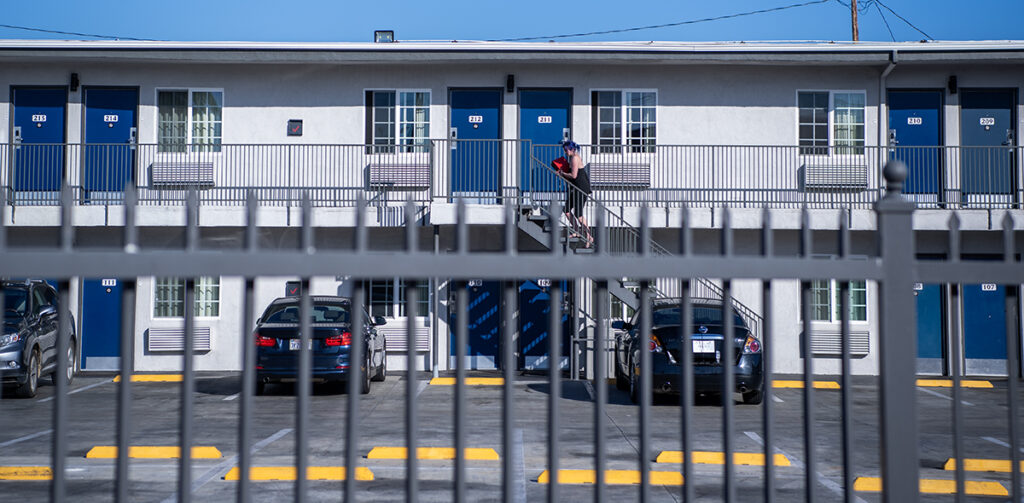Long Beach officials are in final negotiations to lease the 50-room Motel 6 on E. Pacific Coast Highway to house dozens of homeless people who dot the ragged, concrete banks of the Los Angeles River.
The next step, according to a city spokesperson, is to bring the lease agreement before the City Council for a vote. Without a specific date set, officials hope to have it before the dais by December.
If approved, the lease would run for eighteen months. It’s unclear how much it will cost; rooms at the motel, just west of Orange Avenue, typically cost $131 to $177 per night, which could cost upwards of $4.8 million for the program’s duration.
A city spokesperson said Friday that other locations have been considered but aren’t likely to be chosen because they would require “splitting the project across multiple motel sites, which would increase service costs for the program.” The city is not in negotiations with any other motel or hotel, they added.
In its bid outline, city officials said the project will have the capacity to shelter up to 70 people a night. The vendor contract to manage the site would be for one year, with the option to renew for one six-month period.
Twenty rooms at the newly opened shelter at the former Luxury Inn at 5950 Long Beach Blvd. will also be reserved for the riverbed dwellers identified for the program.
The lease is the latest move since the city announced in March a two-year, $17.4 million plan — $11 million coming from a state grant — to begin housing the roughly 250 people living along the 9.5-mile segment of the L.A. River in city limits.

In a similar program, the city previously spent $2.4 million last year to lease the 60-room Vagabond Inn for a year for those roughing it around the downtown Lincoln Park and Billie Jean King Main Library. In its run, the program sheltered 90 people, 26 of whom moved into permanent housing, while another 27 went to the city shelters.
But whereas the last iteration focused on some of the city’s most visible encampments, this round will focus on its most forlorn.
It’s arguably the city’s most ambitious plan to date, meant to help people who are historically skeptical of government assistance, wary of city shelters and far more self-reliant in their survival. It’s a group who nearly all (92%) reported being homeless for more than a year and about a third who openly admitted to struggling with a mental condition, addiction or chronic illness, according to city data.
The motel is about 1.6 miles from the closest entrance to the river.
Those staying at the motel will be offered voluntary, on-site social services: weekly meetings with case managers, counseling, job placement and assistance in finding cheap, permanent housing.

Proponents of the model believe residents should be persuaded, not forced, to accept social services.
Opponents to the program, meanwhile, say its location is poorly chosen.
“We’re being underserved, we’re being neglected and you are clustering with all these other hotels and these unhoused problems on us,” said Moses Alarcon, who runs a barber shop near the motel.
Following a town hall meeting on Oct. 16, residents and nearby businesses asked City Council members to reconsider the program’s placement, out of fear it will scare away customers, debase the neighborhood and invite criminality.
“We’re trying to build this community up on our own without your help,” Alarcon added. “And you’re doing this to us. … Please reconsider this.”
Some raised the concern that too many city shelters and motel leases are unfairly placed in the city’s poor and working-class neighborhoods and not in the affluent ones.
“When cities attempt to place temporary shelters or permanent housing in affluent neighborhoods, they typically face fierce opposition and legal challenges,” resident Lydia Hollie said. “Based on my research, I cannot find any evidence of homeless shelters in the affluent neighborhoods — Naples, Belmont Shore, Bixby area or near the Cal State Long Beach campus.”
Homeless Bureau Director Paul Duncan said Wednesday there is historical accuracy to that claim. But these days, he added, city shelters exist citywide, in every council district except the 5th District, which runs horizontally from East Long Beach past the airport into the Bixby Knolls area. “That being said, they’re open to it,” he said.
But there are few places where the city can find a space cheap and large enough to accommodate their needs, especially in East Long Beach.
“In certain areas, there’s lots of warehouses, more motels and hotels,” Duncan said. “And there’s certain areas of the city where there are fewer hotels (or) motels, fewer warehouse-type buildings that could be converted, and it’s really residential and retail.”
The practice of placing homeless people temporarily in commercial motels is only the latest indication that the city and county are unable to provide shelter for all those who need it.
City data shows its shelter space is typically at 93% occupancy — over 90% capacity since 2022 — while 99% of its emergency housing vouchers are used.
An example of this: The city’s new youth shelter has been delayed “as the City works to ensure appropriate staffing and operations,” according to a health official who added the city hopes to have tens in there by the end of the year.
Without data available on the 85-bed shelter at 702 W. Anaheim St. — funded by the county homeless agency — the city can say more than 2,900 people entered at least one of 37 municipal or private shelters citywide in the past year.
Of those, 970 continue to live in a shelter, while another 318 moved into permanent living situations.
In the past year, as of Oct. 1, the city has provided housing vouchers to 271 people.

